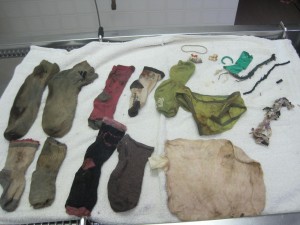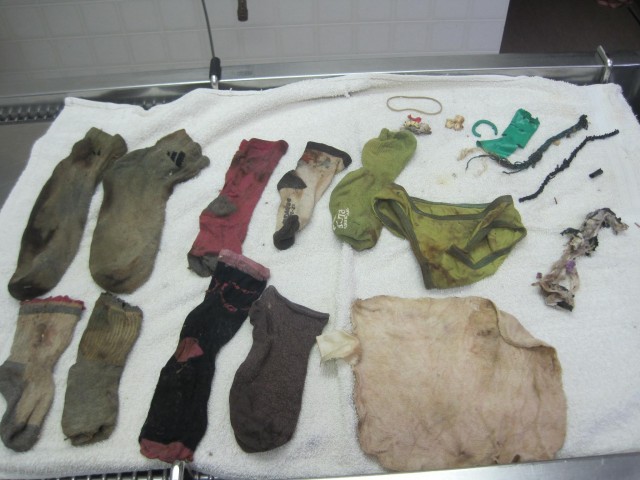A Case Study In Canine Chaos
I have been getting a rash of desperate calls lately from owners with dogs that eat stuff.
I recently fielded a call from a potential client with two neutered male dogs aged 2 and 4.
She had previously lost a middle-aged dog to an emergency bowel resection that turned septic, and had already experienced a few late-night emergency vet visits with both of her current dogs after they had ingested foreign objects.
She shared tales of their exploits with ‘stealing’ and the chaos that usually followed; involving pursuing the dogs and wresting the objects from them, or watching in dismay as they sucked socks like spaghetti noodles. One dog had consumed a half-pound of rich fudge brownies like a vacuum cleaner consumes a dust bunny and the other routinely gobbled garbage as if he hadn’t eaten in ages.
The family was tired of being threatened by the growling from under the dining room table as the humans routinely herded them in some sort of reenactment of a prehistoric fight for the last piece of edible mammoth meat for miles, and decided that it was time for an intervention.
The Cost Of Canine Curiosity
There are a bazillion hazards associated with dogs that eat stuff not meant for digestion, and of their owners trying desperately to get these articles back before they are destroyed or consumed.
I cannot count the calls I get from owners who have lost objects as small as diamond earrings to objects as big as cell phones, television remote controls, articles of clothing, whole baseballs, golf balls, pocket knives both open and closed, lighters, hats, you-name-it; gobbled whole by their pets in the blink of an eye with the appetites of garbage disposals.
I cannot recount the number of owners who have vigilantly observed their dogs bowel movements for signs of the article’s return to them and I cannot imagine the number who have waited hopelessly, vainly for the obstruction to pass unassisted.
The Heartbreaking Outcomes
Unfortunately I DO know a number of dogs who have died from eating stuff they shouldn’t have. I also know a number of dogs who have had the life saving intervention from skilled veterinarians who open them up and fish out the contents of their stomachs or intestines, patch them up and send them home with ‘special diets’ as they recover from their surgeries… to turn around and have to do it again. And again. And again.
I can count those dogs too.
Social media is rife with images of dogs in cones that still manage to acquire articles unfit for canine consumption.
Practical Prevention Strategies
There are a lot of places I can start with this; but I’m going to start at the beginning.
- Put your stuff away, as in where the dog can’t get it. That includes making your kids be responsible for their own stuff and put it away too.
- Supervise the dog appropriately (on a leash, with you, IN THE SAME ROOM AS YOU) so you can prevent him from getting your stuff, or your kids’ stuff.
- If you cannot supervise your dog, confine him in a crate so he cannot get anything but his own stuff.
- If you are lax in your supervision and forget to confine your dog so he does manage to get your stuff, DON’T RUN AFTER HIM AND WRESTLE HIM TO GET IT BACK! To do so sets you up for any portion of the first part of this article, including the creation of resource guarding and the associated growling and biting and even faster consumption of stuff you would rather not have to fish through poo for in order to get back, or pay exorbitant fees for surgery you probably could have prevented if you paid attention to the first point and/or the second point.
Smart Play – Safe Play
- Provide appropriate toys! My rule is: man-made toys (you know, the ones you pay top dollar for made of stuff that your house and its contents are made of) are considered interactive toys and are to be played with under the supervision and with the cooperation of the owner. This way the dog learns appropriate self control as far as acquisition, possession and relinquishment of toys in a controlled and fun way; gets interaction with his owner and equally important, exercise which will mitigate both attention seeking behavior and the boredom that leads to attention seeking behavior.
- Toys of a more organic nature can be used as pacifier toys and can be enjoyed by the dog either in his crate or during ‘quiet times’ (under supervision, of course). Pacifier toys are pretty limited to bones. Big bones. RAW are best, the entire shank if possible, WITHOUT the knuckles. They do not splinter like cooked bones, are digestible and offer HOURS of fascination for most dogs. They can be used effectively for crate training and to help avert resource guarding behaviors if the dog is allowed controlled access either in his crate or while at large (under supervision, of course). Bleached shank bones are good too. You can stuff them with stuff. Stuff that you approve of, like peanut butter (out of a jar from a manufacturer that doesn’t use artificial sweeteners) or pate’ de foie gras if you want. It’s up to you. Not the dog.
- Did I mention adequate exercise? They need to exercise their bodies, they need to exercise their minds. They need this routinely, as in every day, to some degree. For any dogs, young and old alike or any derivatives thereof; a walk around the block once a day or the expectation that he will ‘self exercise’ if his owners turn him out, unattended, in the back yard is just not going to satisfy the dogs’ desire to chase, frolic, run, jump, wrestle, dig or otherwise act like a dog. Leave him to his own devices and he’ll find things to do on his own, like strip the siding off your house, or break teeth chewing the cinder-blocks or bricks that comprise your foundation.
Why We Don’t Chase Dogs
Not lastly, more like firstly, or anytime you forget any of the other important stuff here, never EVER run your dog down to get something back. You invite disaster. Maybe not that time, or even the next time, but I assure you; you are teaching your dog several important things:
- To defend articles with avoidance, escape or aggression
- To run from you, because you look like a giant monster trying to take your dogs’ prize away
- To hide in the cubby under the bed, chair, couch, corner, closet, crate or anywhere the dog feels he can defend himself, and consume his prize
- To chew harder and swallow faster so the bigger predator (YOU) can’t get it.
Don’t set yourself up for failure by trying to wrestle away that sock, or cramming your hand forcibly down a dogs throat after the other half of your sandwich or your kid’s iPod.
You invite disaster by thinking you will be successful. You may be once or twice, but try calling that dog to you after a few sessions like this and see what happens, or better yet, when you REALLY NEED him to drop something, and you move toward him, watch what happens. It ain’t purdy, the things people inadvertently teach their dogs….
Prevention Is Cheaper Than Surgery
They say it is far easier to ask forgiveness than to ask for permission. In the case of dogs who eat stuff, it is far easier to mitigate access and teach them to respond to some basic commands than it is to have to suffer the consequences (and often heartbreak) of having allowed them unfettered access to your stuff.
Be smart. An ounce of prevention and all that. Hiring a good trainer to help you is still way cheaper than obstruction surgery and far less heartbreaking than losing your dog because you accidentally taught him to run away instead of willingly give up the thing you don’t want him to eat.
Get Help!
If your dog has become possessive, or you want to prevent it, we are only an email or phone call away.



I am sending this blog to as many of my customers and clients as I possibly can! I am amazed at how, after expensive surgeries and sleepless nights, the one thing people do not do is remove the temptation from the dog. I know it is hard, I have one (out of four) who can and will find anything to consume. We are ever vigilant and yet he still will snag something of the kitchen table. I hope your blog saves some dogs’ lives.Miriam – AKA MissPoop – Dog Waste Guru (seriously)
Thanks,I’ll be following up this article with one on how to address the problem, beyond the obvious…Mostly, habitual thieves do so out of opportunity. It is a dangerous problem that folks seem to think is “cute” or endearing, until the dog dies, or the vet demands payment. As a Guru, I would assume then that you see a lot of strange “stuff”. I am forever amazed by the things that are deposited on my property the first few days of a dog’s residency. The picture, although not really clear is the remnants of currency whose value still remains undetermined. The partner to this dog is still passing the remnants of the credit cards. The wallet these things came out of was virtually untouched.Talk about your money pits!!